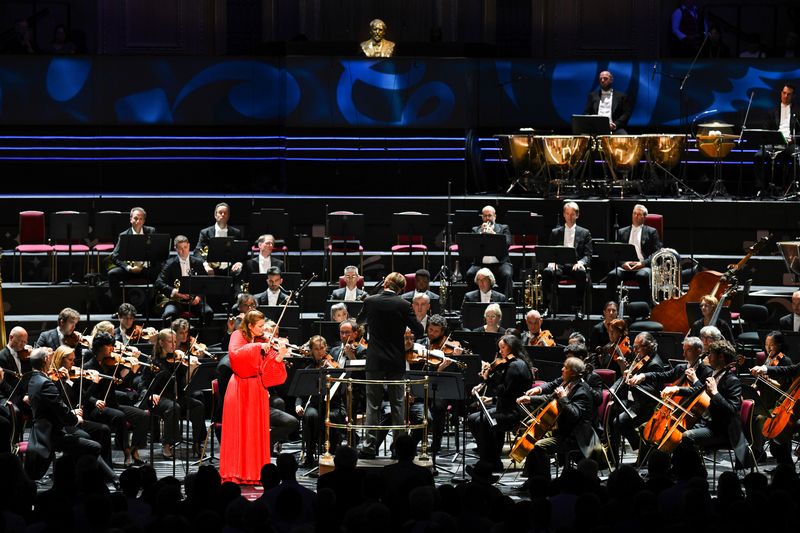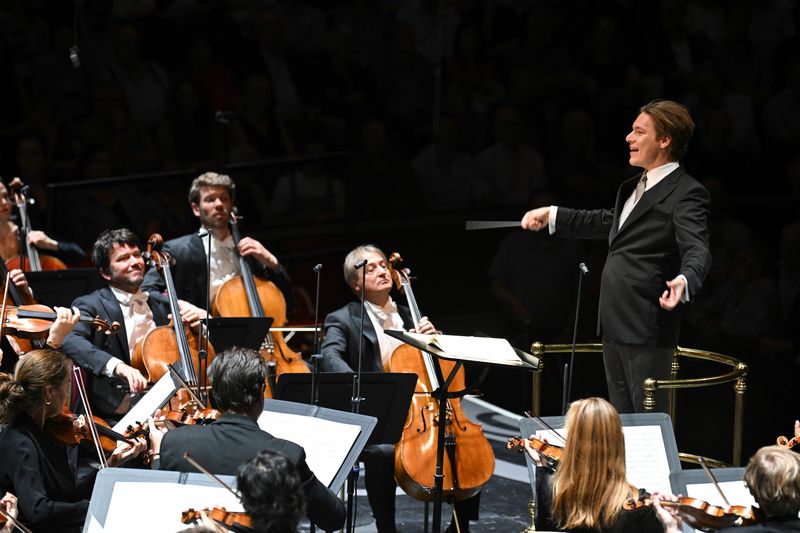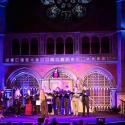How often is an orchestral concert perfect in every texture, every instrumental entry, every phrase? Wednesday's Phiharmonia Prom struck sound-spectrum gold, but its chief conductor, Santtu Matias Rouvali, could do with more humanity. My colleague Rachel Halliburton found his fellow Finn Klaus Mäkelä challenging in Mahler’s Fifth on Saturday night, but on Sunday afternoon neither he nor his fellow musicians put a foot wrong; indeed, feet hardly seemed to touch the ground.
Mozart might have been a style challenge for the Royal Concertgebouw Orchestra's chief conductor elect, most familiar in late romantic works, but the "Paris" Symphony which began the Sunday afternoon concert was elegant, clear-textured, hypersensitive to a range of dynamics, which rendered the instant slips from jubilant major into thoughtful minor align the work with the later symphonic masterpieces, 38-41. To draw every outline in the tricky space of the Albert Hall was not the least of Mäkelä's achievements here.  His partnership with arguably the greatest, certainly the most communicative violinist of our time, Janine Jansen – for me, she's first equal with Vilde Frang – has been well established on a superlative CD featuring Sibelius's Violin Concerto and Prokofiev's First. In the hall, you had to strain to catch the shimmer of strings and the ethereal melody which begin and end the Prokofiev (did the composer establish a first in ending a concerto that way?). Which is as it should be. Jansen made even more of the work than usual sound like fairy music by Mendelssohn - "Mendelssohnism" was a negative tag at the time of the concerto's first performance in 1920s Paris, but it could hardly seem so here – with Caliban joining Ariel only in the whirlwind scherzo. Jansen tuned in to the exquisite Concertgebouw first flute, Emily Beynon, her collegial ear always fine-tuned, as it must be in this other-worldly masterpiece.
His partnership with arguably the greatest, certainly the most communicative violinist of our time, Janine Jansen – for me, she's first equal with Vilde Frang – has been well established on a superlative CD featuring Sibelius's Violin Concerto and Prokofiev's First. In the hall, you had to strain to catch the shimmer of strings and the ethereal melody which begin and end the Prokofiev (did the composer establish a first in ending a concerto that way?). Which is as it should be. Jansen made even more of the work than usual sound like fairy music by Mendelssohn - "Mendelssohnism" was a negative tag at the time of the concerto's first performance in 1920s Paris, but it could hardly seem so here – with Caliban joining Ariel only in the whirlwind scherzo. Jansen tuned in to the exquisite Concertgebouw first flute, Emily Beynon, her collegial ear always fine-tuned, as it must be in this other-worldly masterpiece.
That supernatural, introspective quality, which Rachel picked up on in the Mahler, lifted this performance of Bartók's Concerto for Orchestra above the usual level, though there were no interpretative eccentricities. Brass explosions, when they came, were focused for maximum rhythmic impact throughout the Introduzione, but the poignancy of the oboe theme (from Alexei Ogrintchouk, who better?) augured deepest sadness ahead.  Mäkelä joined the three middle movements together, inscaping the "Game of the Couples" before getting the strangest of withdrawn sounds from those superlative wind players to punctuate the Elegia with the "lake of tears" music from Bluebeard's Castle (the difference between good and outstanding showed after the Budapest Festival Orchestra Prom including that masterpiece). Strings sang their hearts out in stunningly well-defined unisons – it was a pleasure and a surprise to see Zsolt-Tihamér Visontay, co-leader of the Philharmonia, for the second time in a week, this time as guest leader – and the viola theme in the Intermezzo interrotto brought further tears (and yes, the joke on Shostakovich's "Leningrad" Symphony, or the "Chez Maxim" theme from Hitler's beloved Merry Widow, made its raucous mark).
Mäkelä joined the three middle movements together, inscaping the "Game of the Couples" before getting the strangest of withdrawn sounds from those superlative wind players to punctuate the Elegia with the "lake of tears" music from Bluebeard's Castle (the difference between good and outstanding showed after the Budapest Festival Orchestra Prom including that masterpiece). Strings sang their hearts out in stunningly well-defined unisons – it was a pleasure and a surprise to see Zsolt-Tihamér Visontay, co-leader of the Philharmonia, for the second time in a week, this time as guest leader – and the viola theme in the Intermezzo interrotto brought further tears (and yes, the joke on Shostakovich's "Leningrad" Symphony, or the "Chez Maxim" theme from Hitler's beloved Merry Widow, made its raucous mark).
More whisperings gave the finale its special flavour, and parallelled the Mahler Five of the previous evening – another five-movement work with the emphasis on sorrow falling in different places – with added gutsy folk flavour. A final masterstroke was to plunge for the encore into the final sequence from Kodály's Dances of Galánta, giving the wind another moment in the moonlight, above all clarinettist Carlos Ferreira, before the last whirl. Yes, the Concertgebouw has made the right choice, and the players looked very convinced about it at the end. So will the Mäkelä naysayers now please give it a rest?













Add comment